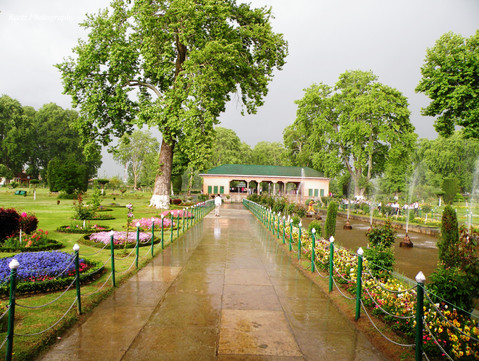Spectacular Char Bagh of Srinagar tourism
- toursandjourneys

- Dec 15, 2019
- 7 min read
Updated: Mar 2, 2020
Discover offbeat trails of Kashmir with our travel expert Reetwika Banerjee
We all know about the four famous gardens of Persia, popularly known as Char Bagh of srinagar tourism. Honestly speaking, I could never imagine there could be such spectacular gardens in our India too! Yes, you read it correct; Srinagar, the state capital of Jammu and Kashmir houses four stunning terraced gardens patronized by the mighty Mughals themselves. They are open six days a week for tourists, except on Fridays from 9am to 6pm.
Char Bagh - Four Mughal Gardens of Srinagar
Needless to say, the architectural patterns of all four are highly influenced by the Persian gardens, offering splendid views of the Zabarwan Range and Dal Lake in one frame of srinagar tourism. They are namely – Chasm-e-Shahi, Pari Mahal, Nishat Bagh and Shalimar Bagh, comprising of the Char Bagh of Srinagar tourism. All the gardens have four things in common – terraced planting, natural source of water (stream or spring), wide view of Dal Lake from four geographic directions and located at the foothills of Zabarwan Range of srinagar tourism.
After back to back tough tours of Sonmarg and Gulmarg, we wanted to relax for a day. What could have been a better choice than the Mughal gardens for that matter? Completing brunch by 11am, we walked up to the taxi stand and hired a tourist cab for disposal to visit all the gardens in one shot.
Chasm-e-Shahi
Out first stopover was Chasm-e-Shahi, which means ‘Beautiful to Eyes’ in Persian. In 1632, it was built by Emperor Shah Jahan for his eldest son Dara Sikoh. The chief architect of this picturesque garden was Ali Mardan Khan, who is also credited as the brain behind many other Mughal parks of srinagar tourism.
The garden welcomes you with a lofty gate painted in brick-red colour, quite common depiction of Mughal architectural style. We got down at the adjoining parking area and walked inside. Entry ticket per person was ten rupees only.
Glimpses of Chasm-e-Shahi
It comprises of a three tiered terraced garden with a natural spring forming its spine. The spring water feeds the first level which further flows down until the lowermost compartment where it sprouts onto a manmade fountain. On an autumn sunset, the garden wears its most beautiful attire. It is a local legend that the spring water of Chasm-e-Shahi of srinagar tourism bears therapeutic property which had also healed Mumtaz Mahal’s skin ailments. If this be the smallest garden of all four, how magnificent with be the rest!
Pari Mahal
Just to the east of Chasm-e-Shahi, lies Pari Mahal, popularly known as ‘Fairy’s House’. It was around fifteen minute’s uphill drive from there. On way we drooled with a bowl of Falooda, and I must say tasting ice-cream in that chilly weather was great fun. This is a must visit place of srinagar tourism.
Secret chamber at Pari Mahal

Pari Mahal was envisioned by Shah Jahan’s eldest son Dara Sikoh in 1650 to study astrology and astronomy as he strongly believed it to be a shelter of fairies. It was perhaps a monastery earlier because the construction of this garden stands apart from the other three, closely resembling a Buddhist abode. There was a big arch at the entrance followed by a dome and a series of quarters. Also, unlike the other gardens, Pari Mahal does not have any captive water source. Gardens are watered through earthen pipelines connecting straight unto Dal Lake of srinagar tourism.
Mysterious chambers of Pari Mahal
Entry fees were same as Chasm-e-Shahi in srinagar tourism. Parking was available at owner’s risk by the side of the road. Ten steps inside and we discovered ourselves lost in a mysterious world. Strange was the construction of those spacious rooms with pigeon holes and the interconnecting underground tunnels between the porches. The architecture resembled royal harem.
There were also hundreds of intertwining corridors inside the main building, perhaps purposely created to confuse people.
The Dark Room - Dara Sikoh's Murder

We came across many hidden bunkers, secret hideouts, dark stairways and clandestine corners. At present it has been transformed into a paramilitary camp as we also could see on duty officers during our visit. We also peeped into the dark chamber where Dara Sikoh was brutally murdered by his youngest brother Aurangzeb. Nevertheless, one should not miss the view of Srinagar from its top patio – truly mesmerizing!This place must be in top priority in srinagar tourism.
View from top of Pari Mahal


Next, we headed towards Nishat Bagh. It was almost 2 o’clock by the time we reached. Arriving there, we thought of having a quick tea break first and then take the tour. Walking the entire garden on foot would demand some additional energy as Nishat Bagh was the biggest of the four Mughal gardens of Srinagar tourism. Just outside the park, we found quite a few joints to rejuvenate our lost vigour.
Nishat Bagh

Nishat Bagh in Persian means ‘Garden of Bliss’ – truly the most extravagant of Char Bagh srinagar tourism. It was built by Emperor Jahangir in 1633. Asaf Khan, alias Mirza Abul Hasan was the chief architect of this royal garden. Built in twelve tiers, each level represents a zodiac sign like Persian gardens. The uppermost portion was the ‘Zenana’ (private section of any Persian palace where only royal maids were allowed). No other garden had such privacy provisions except Nishat Bagh of srinagar tourism.
Nooks and corners of Nishat Bagh
Along the middle of the promenade, a natural stream runs down the Zabarwan peak which finally meets at Dal Lake of srinagar tourism. The lowermost level opens directly to the lake, exhibiting a very unique structural design. At all the twelve levels, the terraced garden is beautifully decorated with aromatic grass, towering chinars, flowerbeds, water cascades and fountains. It is believed that, one among those Chinar trees were planted by Jahangir himself.
Oont Kadal

A historic bridge, popularly known as ‘Oont Kadal’, located on the Dal Lake offers the most scenic view of Nishat Bagh in srinagar tourism. It is said that, the Mughals used to savour private shikara rides at this part of the lake with their Begums which inspired many Bollywood songs of modern times. There is also an ancient fortification (locals call it Hari Parbat fort) on a small island, now in complete ruins, which used to be their lovemaking abode.
Mehendi decoration outside Nishat Bagh

As we were walking out of the garden’s main exit gate, a group of Kashmiri women approached us. They were selling Mehendi tubes. One of them also insisted to try Kashmiri design on my hands. I did not want to miss the chance.
Shalimar Bagh

It was almost quarter to five and we were still left with Shalimar Bagh of srinagar tourism. It is believed to be the oldest of all the Mughal gardens. Built in 1620 by Jahangir, it is divided into two major sections. Kashmir being the summer capital of the Mughals, the garden was built in such a way that it could house both public (Diwan-i-aam) as well as royal (Diwan-i-khaas) durbar halls. Shalimar Bagh is the only garden in Srinagar to house both the courts. Strategically separated, today they are decked with herbaceous decors, fragrant grasses, green fields and water cascades.
Shalimar Bagh - the king of Char Bagh
Full of tourists, we somehow made our way inside. Rightly said, it stands out as the most exquisite Mughal garden – where every corner has something unique to offer; be it a water pool or fountain, flowerbed or fruit orchard, Shalimar Bagh of srinagar tourism will never let you leave with thirsty eyes.
The four turrets (‘burj’ as they say in Persian) were manned in those days to prevent any forceful entry to the private section of the garden. The bricks of this section were specially made for greater strength; however the walls were hidden behind colourful stone paintings from outside.
Water hopping at Diwan-i-Khaas

It took us more than an hour to complete the tour of Shalimar Bagh. Way back, we met a very interesting person – he introduced himself as an old fakir, rather a self-proclaimed guide. As per him, no one in Kashmir holds more knowledge about the Mughal gardens than him. At first, we did not encourage him to speak much, but later as he shared a few stunning facts about the gardens, it made us listen to him with an attentive ear.
View from top of Burj
During early 4th century BC, the area used to be the residence (tapovan) of a Hindu ascetic, who had named it as Shalimar Vatika. Innumerable fruit and flower trees were planted by him and his disciples to decorate the place. With the passage of time, it gave rise to a beautiful ecosystem full of flora and fauna. Slowly people from other places also started walking in, turning the orchard into a small village. Centuries later, Shalimar was struck by a devastating famine and everyone died, except the old saint.
Later during 6th century BC, Hindu ruler Pravarassena II rediscovered Shalimar and constructed a temple. Over the years, with the change in royal seats, Shalimar also lost its glory. Surprisingly the name survived in the minds of local people. Much later in the 16th century when Muslims invaded Kashmir, they constructed an embankment near the sacred Hindu temple and named it Shalimar Bund. Surrounding it, trees started growing, slowly giving rise to a landscaped garden. In 1620, it was Emperor Jahangir who fashioned the garden to a royal courtyard and named it Shalimar Bagh of srinagar tourism. That’s the history of this piece of Mughal extravaganza.
Water cascade of Shalimar Bagh

Way back to our hotel, we also visited the famous Hazratbal Mosque of srinagar tourism. The gorgeous white marble beauty is another edifice of Islamic daintiness. The relic inside the shrine (Moi-e-Muqqadas) is commonly believed to be Prophet Muhammad’s hair, hence the name Hazratbal Masjid. Situated on the northern side of Dal Lake, it is one of the most sacred tombs of Kashmir.
Hazrat Bal Mosque

Glance through Hazrat Bal Shrine
The area around the mosque is full of local shops selling dry fruits, woodworks, woolen garments, saffron etc. There was an old man standing in front of a woodcraft shop. While passing by, he warmly invited us inside. Later we came to know he is the artisan of all the fabulous craftworks on display. We too ended up purchasing authentic Kashmiri handicrafts worth thousands. Finally we had to buy a duffle bag to carry them back to hotel. Lolz.
Kashmiri Woodworks
Sunglasses to protect the eyes from sunrays, sneakers for walking comfortably, and caps to look trendy as well as from the heat.


























































Comments